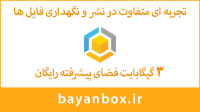|
دانلود مقاله ترجمه شده تکنولوژی زبان
تکنولوژی زبان |

|
| دسته بندی | کامپیوتر و IT |
| فرمت فایل | |
| حجم فایل | 314 کیلو بایت |
| تعداد صفحات فایل | 11 |
بخشی از ترجمه فارسی:
قلمرو
تکنولوژی های زبانی تکنولوژی
اطلاع رسانی هستند که متخصص پرداختن به پیچیده ترین رسانۀ اطلاع رسانی در
جهان ما یعنی: زبان انسانی، هستند بنابراین، این تکنولوژیها نیز اغلب تحت
اصطلاح تکنولوژی زبان انسانی قرار می گیرند . زبان انسانی به شکل گفتاری و
نوشتاری ظاهر میشود. در حالی که گفتار قدیمی ترین و طبیعی ترین شیوۀ
ارتباطات زبانی است، با این حال ،اطلاعات پیچیده و بخش اعظم دانش انسانی
در متون نوشتاری نگهداری و منتقل می شود . تکنولوژی های گفتار و متن با
استفاده ازاین دو شیوۀ درک اقدام به پردازش و ایجاد زبان می کنند . اما
زبان جنبه هایی نیز دارد که در میان گفتار و متن مشترک هستند از قبیل کتب
فرهنگ لغت، بخش اعظم دستورزبان ، و معنی جملات . بنابراین ، بخش های بزرگی
از تکنولوژی زبانی را نمی توان در زمرۀ تکنولوژی گفتار و متن قرار داد .
در میان آنها تکنولوژی هایی هستند که زبان را به دانش متصل می کنند . ما
نمی دانیم که چگونه زبان ، دانش و اندیشه در مغز انسان بازنمود می یابند .
با این حال ، تکنولوژی های زبان ناگزیربه ایجاد سیستم های بازنمود رسمی
که زبان را به مفاهیم و وظایف در دنیای واقعی پیوند می دهند، هستند . این [
تکنولوژی] میانجی و واسطی را به حوزه سریعا در حال رشد تکنولوژی دانش
فراهم می کند.
ما دربرقراری ارتباط ، زبان را با دیگر شیوه های
ارتباطات و دیگر رسانه های اطلاع رسانی در هم می آمیزیم. گفتار را با
حالات دست و سر و صورت ترکیب می کنیم . متون دیجیتال با تصاویر و صداها
ترکیب می شوند . حرکات ممکن است حاوی زبان و شکل گفتاری و نوشتاری باشند .
بنابراین تکنولوژی گفتار و متن با بسیاری از تکنولوژی های دیگر که پردازش
ارتباطات چند مدلی و اسناد چند رسانه ای را تسهیل می کنند، همپوشانی و
تعامل دارند.برای آشنایی جامع با این حوزه ، خوانندگان این مقاله رابه
ColeR.A., J.Mariani, H.Uszkoreit, G.Varile, A.Zaenen, V.Zue, A.Zampolli
(Eds.) (1997)Survey of the State of the Art in Human Language
Technology , Cambridge University Press and
Giardini.(http://www.dfki.de/~hansu/HLT-Survey.pdf)
ارجاع می دهیم.
2- کاربرد
اگر چه سیستم های LT موجود
از رسیدن به قابلیت انسانی دور هستند ، با این حال کاربرد های احتمالی
متعددی دارند. هدف آنهاایجاد محصولات نرم افزاری است که تاحدی دانش زبان
انسانی را داشته باشند. قراراست که اینگونه محصولات زندگی مان را تغییر
دهند و وجود آنها جهت بهبود تعامل میان انسان با ماشین کاملا ضروری است
زیرا مانع اصلی در تعامل میان انسان و کامپیوتر صرفا وجود یک مشکل ارتباطی
است . کامپیوترهای امروزی زبانمان را درک نمی کنند اما یادگیری زبان های
کامپیوتری دشوار است و به ساختار اندیشه انسانی مربوط نمی شوند . حتی اگر
زبانی را که ماشین درک می کند و نیزدامنۀ بحث آن بسیار محدود باشد ، باز
هم ، استفاده از زبان انسانی می تواند پذیرش نرم افزار و بهره وری کاربران
آن را افزایش دهد.
” تکنولوژی دوستانه” باید گوش دهد و صحبت
کندمیانجی های زبان طبیعی کاربر را به برقراری ارتباط با کامپیوتر به زبان
فرانسه ، انگلیسی ، آلمانی ، یا دیگر زبانهای انسانی قادر می سازند. برخی
از کابردهای چنین میانجی هایی عبارتند از پرس و جوهای پایگاههای داده ای ،
بازیابی اطلاعات از متون ، سیستم های موسوم به خبره ، کنترل روباتی.
ارتباط با کامپیوترها با استفاده از زبان گفتاری اثر ماندگاری بر محیط
کاری خواهد داشت . حوزه های کاملا جدیدی برای کاربرد تکنولوژی اطلاع رسانی
باز خواهند شد.
هرچند لازم است که زبان گفتار را با دیگر شیوه های
ارتباطی از قبیل اشاره کردن با ماوس یا انگشت ترکیب نمود . اگربتوانیم
چنین ارتباط چند مدلی را سرانجام در مدل عمومی موثر تعاون تجسم ببخشیم ،
آنگاه در تبدیل ماشین به یک شریک موفق شده ایم . هدف غایی تحقیق دسترسی
فراگیر به همۀ انواع تکنولوژی و به ساختار اطلاع رسانی جهانی از طریق
تعامل طبیعی است . در یک سناریوی جاه طلبانه اما نه چندان دور از ذهن ،
تکنولوژی زبانی میانجی را برای یک هوش فراگیرکه ارائه دهندۀ کمک در سر کار
و در بسیاری از وضعیتهای زندگی روزمره است فراهم می آورد.
ماشین ها همچنین می توانند به افراد برای برقراری ارتباط با همدیگر کمک کنند.
تکنولوژی های زبانی همچنین می توانند به افراد کمک کنند تا با همدیگر
ارتباط برقرار کنند. مشکلات ارتباطی میان افرادی که زبانهای مادری متفاوت
دارند. در مقایسه با مشکلات میان موجودات بشری و ماشین ها از قدمت بیشتری
برخوردارند. همیشه یکی ازهدفهای اصلی تکنولوژی زبانی ترجمه کاملا خودکار
میان زبانهای انسانی بوده است . دانشمندان از تجربۀ تلخ نتایج گذشته
دریافته اند که هنوزهم از رسیدن به هدف جاه طلبانه ترجمۀ متون نامحدود
بسیار دورند. با این حال ، آنها توانسته اند سیستم های نرم افزاری را ایجاد
کنند که کار مترجمان انسانی را ساده می کنند و بهره وری آنها را بوضوح
بهبودمی بخشند . ترجمه های کمتر از تمام خودکار نیز می توانند برای جستجو
کنندگان اطلاعات که ناگزیرند در میان مقادیر زیادی متن به زبانهای خارجی
اطلاعات موردنیاز خود راجستجو کنند، کمک بزرگی باشند.
جدی ترین گلوگاه
تجارت الکترونیک حجم ارتباطات میان موسسات تجاری و مشتریان یا در میان
موسسات تجاری می باشد. تکنولوژی زبانی می تواند به مرتب سازی ، تصفیه سازی
و مسیر سازی نامه های الکترونیک وارده کمک کند . همچنین می تواند به عامل
ارتباطی مشتریان جهت جستجوی اطلاعات و نوشتن پاسخ کمک کند . در مواردی که
پرسشها از قبل پاسخ داده شده اند ، تکنولوژی اطلاعات می تواند پاسخ های
مناسب سریع تری را بیابد و بطور خودکار به آنها پاسخ دهد .
بخشی از مقاله انگلیسی:
1. Scope Language technologies are information technologies that are specialized for dealing with the most complex information medium in our world: human language. Therefore these technologies are also often subsumed under the term Human Language Technology. Human language occurs in spoken and written form. Whereas speech is the oldest and most natural mode of language communication, complex information and most of human knowledge is maintained and transmitted in written texts. Speech and text technologies process or produce language in these two modes of realization. But language also has aspects that are shared between speech and text such as dictionaries, most of grammar and the meaning of sentences. Thus large parts of language technology cannot be subsumed under speech and text technologies. Among those are technologies that link language to knowledge. We do not know how language, knowledge and thought are represented in the human brain. Nevertheless, language technology had to create formal representation systems that link language to concepts and tasks in the real world. This provides the interface to the fast growing area of knowledge technologies. In our communication we mix language with other modes of communication and other information media. We combine speech with gesture and facial expressions. Digital texts are combined with pictures and sounds. Movies may contain language and spoken and written form. Thus speech and text technologies overlap and interact with many other technologies that facilitate processing of multimodal communication and multimedia documents. For a comprehensive introduction to the field, the reader is referred to: Cole R.A., J. Mariani, H. Uszkoreit, G. Varile, A. Zaenen, V. Zue, A. Zampolli (Eds.) (1997) Survey of the State of the Art in Human Language Technology, Cambridge University Press and Giardini. (http://www.dfki.de/~hansu/HLT-Survey.pdf) speech technologies text technologies knowledge technologies multimedia & multimodality technologies language technologies Hans Uszkoreit – 2 – Language Technology 2. Applications Although existing LT systems are far from achieving human ability, they have numerous possible applications. The goal is to create software products that have some knowledge of human language. Such products are going to change our lives. They are urgently needed for improving human-machine interaction since the main obstacle in the interaction between human and computer is merely a communication problem. Today’s computers do not understand our language but computer languages are difficult to learn and do not correspond to the structure of human thought. Even if the language the machine understands and its domain of discourse are very restricted, the use of human language can increase the acceptance of software and the productivity of its users. Friendly technology should listen and speak Natural language interfaces enable the user to communicate with the computer in French, English, German, or another human language. Some applications of such interfaces are database queries, information retrieval from texts, so-called expert systems, and robot control. Current advances in the recognition of spoken language improve the usability of many types of natural language systems. Communication with computers using spoken language will have a lasting impact upon the work environment; completely new areas of application for information technology will open up. However, spoken language needs to be combined with other modes of communication such as pointing with mouse or finger. If such multimodal communication is finally embedded in an effective general model of cooperation, we have succeeded in turning the machine into a partner. The ultimate goal of research is the omnipresent access to all kinds of technology and to the global information structure by natural interaction. In an ambitious but not too far-fetched scenario, language technology provides the interface to an ambient intelligence providing assistance at work and in many situations of daily life. Machines can also help people communicate with each other Language technologies can also help people communicate with each other. Much older than communication problems between human beings and machines are those between people with different mother tongues. One of the original aims of language technology has always been fully automatic translation between human languages. From bitter experience scientists have realized that they are still far away from achieving the ambitious goal of translating unrestricted texts. Nevertheless, they have been able to create software systems that simplify the work of human translators and clearly improve their productivity. Less than perfect automatic translations can also be of great help to information seekers who have to search through large amounts of texts in foreign languages. The most serious bottleneck for e-commerce is the volume of communication between business and customers or among businesses. Language technology can help to sort, filter and route incoming email. It can also assist the customer relationship agent to look up information and to compose a response. In cases where questions have been answered before, language technology can find appropriate earlier replies and automatically respond. Language is the fabric of the web The rapid growth of the Internet/WWW and the emergence of the information society pose exciting new challenges to language technology. Although the new media combine text, graphics, sound and movies, the whole world of multimedia information can only be structured, indexed and navigated through language. For browsing, navigating, filtering and processing the information on the web, we need software that can get at the contents of documents. Language technology for content management is a necessary precondition for turning the wealth of digital information into collective knowledge. The increasing multilinguality of the web constitutes an additional challenge for language technology. The global web can only be mastered with the help of multilingual tools for indexing and navigating. Systems for crosslingual information and knowledge management will surmount language barriers for e-commerce, education and international cooperation. Hans Uszkoreit – 3 – Language Technology 3. Technologies In the following a selection of the most relevant language technologies will be summarized. By clicking on the names of the technologies, you can access additional information. Speech recognition Spoken language is recognized and transformed in into text as in dictation systems, into commands as in robot control sy






